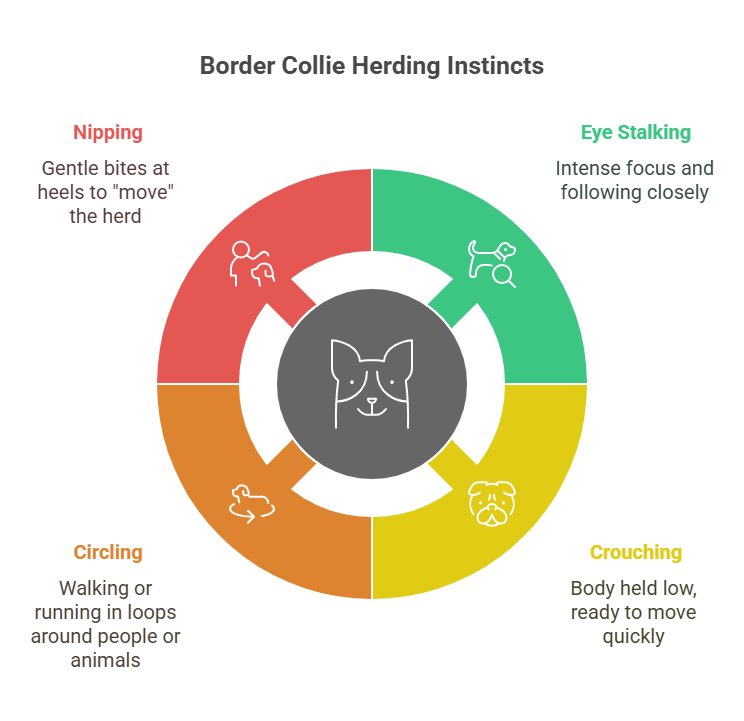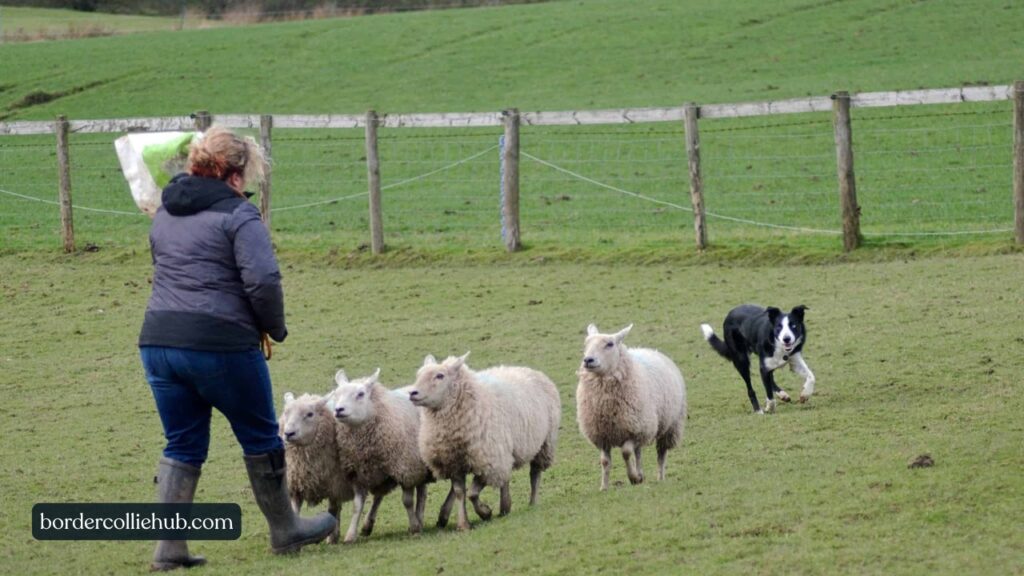Border Collies have a strong herding instinct—they were bred to control livestock using eye contact, stalking, and circling. This behavior is natural and not a problem, but it does need proper training and mental stimulation to keep your dog happy and healthy.
If your Border Collie keeps chasing kids, bikes, or even other pets, you’re not alone. This breed is known for its laser-sharp focus and nonstop energy. While these traits make them amazing workers, they can also confuse or frustrate everyday owners. Why is your dog doing this? Is it bad behavior—or something deeper?
The answer lies in their herding instinct. Understanding this powerful drive can help you raise a calmer, more focused dog. In this article, you’ll learn exactly what the herding instinct is, how it shows up in daily life, and simple ways to turn it into a strength. Let’s walk through it step-by-step—with clear tips and real-life examples.
What is the Herding Instinct in Border Collies?

Definition of herding instinct in working dogs
Herding instinct is a natural behavior passed down through generations of working dogs. It’s not taught—it’s something these dogs are born with. In Border Collies, this instinct is especially strong. They have been bred for centuries to help control sheep, cattle, and other animals.
The herding drive is based on a dog’s natural predatory sequence. Instead of chasing to kill, herding dogs stop just before the final step. This means they stalk, crouch, and chase, but they don’t attack. Their job is to move animals without hurting them.
The evolutionary role of herding in dog breeds
The herding instinct began as a useful skill for farmers. Over time, certain dog breeds were chosen and bred for their ability to control animals calmly and smartly. Border Collies became the best at this job. Their intense focus, quick reactions, and strong desire to work make them perfect for the task.
This instinct also means they have a strong need for purpose. Without work, a Border Collie may become restless or even destructive. That’s why it’s so important for owners to understand where these behaviors come from.
Why Border Collies have one of the strongest herding instincts
Border Collies lead the pack when it comes to herding. They’re often described as having “the eye,” a steady stare used to control livestock. This trait, combined with their crouching body posture, allows them to move animals without barking or biting.
Other breeds herd with barks or nips. Border Collies use silence and movement. This quiet, focused method is what sets them apart—and makes their instinct both amazing and challenging for the average pet home.
How the Herding Instinct Manifests in Border Collies

Common herding behaviors (eye stalking, circling, crouching, nipping)
At home, a Border Collie’s herding instinct can look confusing. You may see your dog staring at you, circling family members, or trying to control movement in the yard. This isn’t bad behavior—it’s instinct.
Some common signs include:
- Eye stalking: the dog locks eyes and follows closely
- Crouching: body held low, ready to move quickly
- Circling: walking or running in loops around people or animals
- Nipping: gentle bites at heels to “move” the herd
These actions come from deep inside your dog’s brain. They aren’t trying to be naughty—they’re trying to do their job.
Triggers for herding responses in daily environments
Everyday sights and sounds can spark a herding reaction. Fast-moving things like children, bikes, or squirrels can flip that instinct “on.” Even doorbells or running water might cause a reaction.
If your dog tries to herd your kids during playtime, or chases joggers on walks, it’s likely their instinct at work. Knowing the triggers helps you prevent trouble and plan better training.
Real-life examples: herding children, bikes, or other pets
One common story from Border Collie owners is their dog chasing children. The fast movement mimics livestock. Without training, the dog might try to “round up” the kids. The same happens with cats, skateboards, or vacuum cleaners.
Even other dogs at the park may get herded. Some Collies will run circles around play groups, trying to restore order.
Understanding these moments as instinct—not disobedience—helps you manage them kindly and calmly.
Benefits and Challenges for Pet Owners

How herding drive helps with agility, obedience, and stimulation
The herding instinct, when used well, is a huge plus. It gives your dog purpose. Border Collies shine in agility, obedience, and advanced tricks. Their ability to focus and learn makes training rewarding and fun.
Because they crave tasks, these dogs love having jobs. Teaching them commands, games, and sports can give them the outlet they need.
Challenges like nipping, chasing, and obsession
But without structure, the same instinct can cause problems. Some Border Collies get obsessed with lights, shadows, or spinning objects. Others nip at heels or bark at anything that moves. These behaviors can confuse or frustrate owners.
If a Collie doesn’t get enough stimulation, they may “create” work—often by herding people, pets, or objects in the house.
Identifying when herding becomes problematic behavior
Not all herding is helpful. When your dog begins to herd in ways that scare children or stress other pets, it’s time to step in.
Here’s a quick way to tell the difference:
| Behavior | Normal Herding | Problem Herding |
|---|---|---|
| Watching and circling | ✅ | ✅ |
| Nipping gently | ✅ | ⚠️ |
| Chasing nonstop | ⚠️ | ❌ |
| Ignoring commands | ❌ | ❌ |
When you see behaviors move into the warning or problem zone, it’s a sign your dog needs more guidance, outlets, or expert training. You can also learn more about managing herding behavior from trusted sources.
Training Tips to Channel the Herding Instinct Positively
Structured obedience and impulse control
Training a Border Collie starts with clear rules and consistent practice. Obedience training is key to managing their instinct in a healthy way. Start with simple commands like sit, stay, and leave it. Use short, upbeat sessions with praise and rewards.
Impulse control is also important. Teach your dog to pause before reacting to movement. Games like “wait and release” or having them hold a position while something moves past can help them stay calm and focused.
Professional dog trainers often use positive reinforcement and clicker training to guide these smart dogs. You can find many training guides for herding breeds from certified dog professionals.
Herding-specific sports and activities (e.g., Treibball, agility)
If your dog wants to herd, give them a safe way to do it. Herding-style sports keep their mind and body active. Here are a few fun ideas:
- Treibball: Dogs push large balls into a goal using herding techniques.
- Agility courses: Running through tunnels, jumps, and weave poles builds focus.
- Rally obedience: A mix of walking and commands to boost control.
- Flyball or frisbee: These fast-paced games feed their chasing instinct.
These outlets give your Collie a way to use their energy without causing trouble at home. They also strengthen your bond.
Mental enrichment ideas to reduce frustration
Mental work is just as important as physical play. Border Collies love to learn. Here are some ways to challenge their brain:
- Puzzle toys that hide treats
- Hide and seek games with toys or food
- Teaching new tricks or skills every week
- “Name the toy” training where each toy has a name
Try rotating toys and tasks to keep things fresh. Boredom leads to frustration, which can make instinctual behaviors worse.
Redirecting instinct without suppressing natural behavior
You don’t need to “stop” the herding instinct. Instead, shape it into safer behavior. For example:
- If your dog nips heels, redirect them with a toy or cue.
- If they stalk the cat, use a “leave it” command and reward calm behavior.
- If they herd children, give them a job—like fetching a ball or doing a trick.
The goal is to guide, not punish. When your dog feels useful and understood, they behave better and feel happier.
Border Collies vs. Other Herding Breeds
Each herding breed has its own strengths. Some use barking, others use movement or pressure. Knowing the difference can help owners choose the right fit for their home.
| Breed | Herding Style | Energy Level | Pet Suitability |
|---|---|---|---|
| Border Collie | Eye contact, crouching, circling | Very High | Best for experienced, active owners |
| Australian Shepherd | Loose-eyed, driving, vocal | High | Good for active families |
| Blue Heeler (ACD) | Heel nipping, strong push drive | High | Needs strong training and structure |
| Shetland Sheepdog | Barking, circling | Moderate | Great for families and kids |
| Belgian Malinois | Controlling with speed and energy | Very High | Best for working or sport homes |
Conclusion
The herding instinct in Border Collies is one of the breed’s most defining traits. It gives them purpose, intelligence, and incredible working ability. But it also brings unique challenges in modern homes.
Understanding this instinct helps you connect with your dog on a deeper level. Instead of fighting their nature, you can guide it with the right mix of training, exercise, and enrichment. Whether you’re raising a farmhand or a city companion, the key is the same: channel the energy, don’t suppress it.
By working with your Border Collie’s instincts—not against them—you’ll raise a happier, calmer, and more confident dog.
Frequently Asked Questions About Border Collie Herding Instinct
What age do Border Collies start herding?
Most Border Collies show herding behaviors as early as 6 to 12 weeks old. Puppies may crouch, stare, or try to herd their littermates. These signs grow stronger with age.
Can herding behavior be dangerous?
Herding itself isn’t dangerous, but it can cause problems in the wrong setting. Nipping or chasing kids, bikes, or cars can become a safety issue. With proper training and outlets, these risks can be managed or avoided.
How do I know if my Collie is herding or just playing?
Herding has a certain “look”—focused eyes, body low to the ground, and precise movement. If your dog is running randomly, it’s play. If they’re controlling direction and watching closely, it’s likely herding behavior.
Is herding a sign of intelligence in dogs?
Yes, it often is. Border Collies are ranked as one of the smartest dog breeds. Their instinct to herd shows strong focus, memory, and problem-solving skills. That’s why they thrive in advanced training and working roles.
Can herding be trained out of a dog?
Not completely. The herding instinct is genetic. However, it can be shaped, managed, and directed. With time, training, and patience, most Border Collies can live happy lives without causing herding-related problems.
